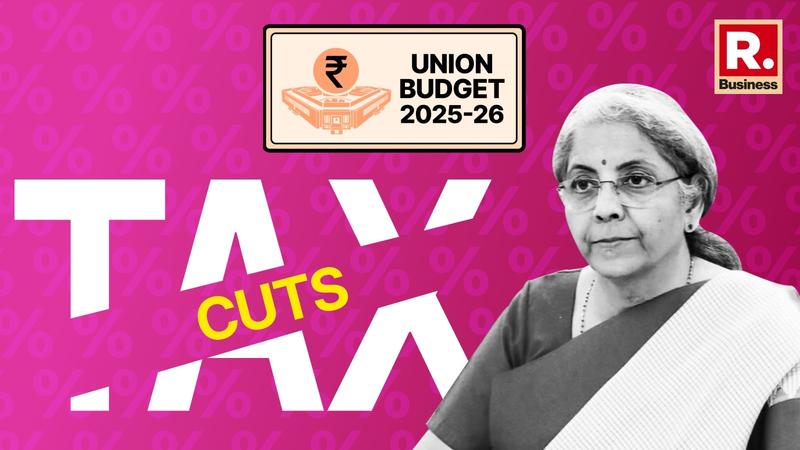Published 21:17 IST, January 3rd 2025
Budget 2025: Tax Reduction Or Rationalisation? What Will FM Nirmala Sitharaman Opt for? Expert Take
CII president Sanjiv Puri in a meeting with FM pitched for a reduction of marginal income tax up to Rs 20 lakh to stimulate demand.

The clamour for tax cuts is growing louder and louder- with industry bodies chipping in with ideas of rationalising the tax slabs and increasing the tax bracket from current 7 lakh to 20 lakh per annum. As the date of Union Budget 2025 is just a few days away, all eyes are on what FM Nirmala Sitharaman has in store for Aam Aadmi. But before understanding the tax restructuring all industry bodies are vouching for, it's pertinent to understand the timing of this ask.
So, the Indian economy despite being the fifth largest, fastest growing economy in the world, is facing challenges. The subdued consumption has emerged as a formidable problem at a time when high inflation has eroded the purchasing power of people. In fact the slow growth number in Q2 at 5.4 per cent raised concerns amongst the economy watchers. The argument to revive the sanguine consumption story is to give more money or simply more disposable income in the hands of people. This is exactly what is driving all industry bodies to moot the same idea of personal income tax cut to revive the consumption and demand story to boost growth.
Why Tax Cut?
That is all about timing. Let's look at the asks. In a pre-budget consultation meeting with the Finance Minister, industry bodies, economists, and tax cuts dominated the larger part of the discussion. Industry body CII pitched for slashing income tax. CII president Sanjiv Puri in a meeting with FM pitched for a reduction of marginal income tax up to Rs 20 lakh to stimulate demand.
“I feel the government will not go for having zero taxation till Rs 15 lakh per annum rather they will go for restructuring of the tax slabs or maybe increase the threshold limit of Rs 7 lakh per annum,” Ved Jain, tax expert and past President at The Institute of Chartered Accountants of India told Republic Business.
The expectations are high, but the significant tax evolution over the years the introduction of a new tax regime, and its rising popularity may push the government not to undertake significant tax reforms, especially on the personal income tax front.
“Over the last few years, the Government has made substantial changes to the personal tax regime (New Tax Regime) with an intent to simplify personal taxes and ease the compliance burden. The new tax regime was made the default tax regime from FY 2023-24 and was reflective of the Government's intent to popularize and adopt the same. Published statistics indicate that for FY 23-24, for returns filed up to 31 July 2024, 72 per cent of taxpayers opted for the New Tax Regime compared to 28 per cent who chose the Old Tax Regime,” Parizad Sirwalla, Partner and National Head – Tax, Global Mobility Services KPMG Assurance & Consulting Services India told Republic Business.
Tax Cut or Not?
According to Sirwalla, in the last July Budget also, the finance minister had further realigned the income tax slabs under the new income tax regime. “Since various changes have been carried out over the years to the personal tax regime, it would need to be seen that Budget 2025 introduces substantial changes on this front.” Siwalla opines. When some tax experts believe the government will not go for any bigbang rate cut, Shailesh Haribhakti, Chairman of the Board, Shailesh Haribhakti and Associates believes this is the right time for tax rationalisation as the tax buoyancy is quite high and tax-to-GDP ratio has stayed robust.
If you go by statistics, the share of direct taxes in GDP rose to a level which was highest in the last 24-years at 6.64 per cent in FY24. In fact, direct tax collection grew more than the growth in FY24. The growth stood at 8.42 per cent during the year and direct tax collections growth grew by 17.82 per cent. However, in FY23, the difference between growth and tax collection growth was not that wide. The nominal GDP in FY23 stood at 15.11 per cent and the tax collection was 17.79 per cent.
“I feel the government will go for tax rationalisation, as this is the right time to do so as the tax revenue has been buoyant. The tax to GDP ratio is similar to the developed economies. The direction that the government will take will be triangular based on simplicity, rationality, and stability,” tax expert Shailesh Haribhakti told Republic Business. He believes this is the right time as the incremental tax gathered is multiple times of GDP. Haribhakti believes the government will go for rationalisation of slabs and will lift the exemption ceiling of Rs 7 lakh per annum.
Only time will tell what relief FM Sitharaman will provide to Aam Aadmi. Whether she goes for a tax rate cut or not but one thing is sure tax reforms will continue and is a never-ending process.
“Tax cut is an expectation that relief should be provided to the low-mid income taxpayers. The last 10 years have seen a lot of focus on simplification, transparency, and ease of compliance for taxpayers. Many initiatives were taken - New tax rate regime with very few incentives/deductions, E-filing made smoother, Taxpayers Charter etc. It is an ongoing process…,” Saurabhi Marwah, Partner, People Advisory Services, EY told Republic Business.
Updated 21:18 IST, January 3rd 2025